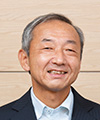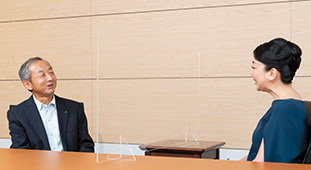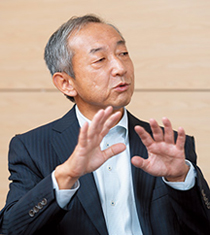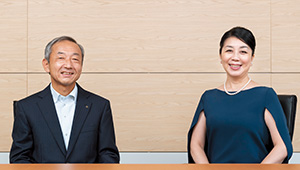 |
|
|
|
|
|
View from the Top Vol. 18, No. 11, pp. 1–5, Nov. 2020. https://doi.org/10.53829/ntr202011tp1
Listening to Employees°« Thoughts and Wishes Then Make Them a RealityOverviewIn 2019, NTT InfraNet celebrated its 20th anniversary. Based on its original mission of providing total management solutions for infrastructure facility operations, the company is reshaping its business to accord with the current times and undertaking initiatives such as responding to natural disasters, reforming work style by improving productivity and efficiency, and solving social issues. We asked Yoshihiro Kuroda, President of NTT InfraNet, about his leadership style and smart infrastructure management solutions that use the technological capabilities required of telecommunication infrastructure professionals. Keywords: infrastructure facility management, digital transformation, smart maintenance Reshaping the infrastructure facility management business to go forward—It has been four years since your last appearance in “View from the Top.” Please tell us about NTT InfraNet from your new position as president. NTT InfraNet was established in 1999 as a subsidiary of NTT EAST. As a group of experts who have fully and uniformly inherited the business and technical expertise related to telecommunication infrastructure facilities such as underground conduits and manholes, we have engaged in the management of the infrastructure facilities of NTT Group companies such as NTT EAST, NTT WEST, NTT DOCOMO, and NTT Communications. In July 2019, to create a business that can be provided to companies other than NTT Group with the Smart Infra Platform by centralizing infrastructure data in a three-dimensional (3D) manner, we became a wholly owned subsidiary of NTT holding company, changing ownership from NTT EAST. Moreover, we took over the civil-engineering infrastructure and business of NTT Communications, acquired NTT Geospace and AIREC Engineering as subsidiaries in December 2019 and March 2020, respectively, and merged with NTT Geospace in July 2020. Although the operation and maintenance of infrastructure facilities within the NTT Group has already been unified, the requirements of each company slightly differ. Accordingly, since taking up my post in June 2019, I have been working on creating a system for efficiently operating and managing these infrastructure facilities. The infrastructure possessed by the NTT Group includes about 670,000 km of underground conduits, through which cables run, about 690,000 manholes, and about 654 km of tunnels called service tunnels. The volume of these facilities is about the same as that of the domestic water supply. Since the total length of all domestic gas pipes is about 270,000 km, it is easy to see that the length of our conduits far exceeds that length. Development of a database is indispensable for efficiently operating and managing these infrastructure facilities, and using the database in more-advanced ways will lead to the establishment of the Smart Infra Platform. It has been 40 to 60 years since the peak of construction of these infrastructure facilities in Japan, and the civil engineers who maintain them are, naturally, aging, and the working population will continue to decline. It is necessary to maintain efficient operation and management of many infrastructure facilities. Information about infrastructure facilities had mainly been managed on paper; however, we want to respond to aging facilities and shortage in the workforce by speeding up digital transformation (DX), such as digitizing information about infrastructure facilities and using it for tasks on devices such as tablets and making inspections and other tasks smarter by using information and communication technology (ICT). In July 2020, we launched the Smart Infra Business Concept to create the Smart Infra Platform by building a centralized database of infrastructure facilities using ICT, which will also be used by infrastructure companies other than the NTT Group. Through these initiatives, we want to contribute to society while increasing our profits.
—What specific changes will DX bring to your daily work? Managing 3D and 4D facility data on the Smart Infra Platform makes it possible to not only improve the efficiency of our work but also smoothly coordinate work for constructing roads, for example. As with communication cables, electric-power pipelines and cables, gas pipes, water pipes, and so on are generally buried under roads. When constructing roads, it is necessary to check the status of these facilities underground and visit the offices of their owners and users individually to discuss the method of construction (excavation). By storing the facility data of each company on the Smart Infra Platform, one can check the status of these facilities in one step, thereby simplifying the procedure and further reducing the number of on-site observations. In the future, when it will be possible to search for infrastructure-facility information on the Internet, we will be able to help solve social issues such as reducing overlapping investments due to repeated excavation and backfilling by individual construction works for electricity, gas, water supply, and telecommunications and relieving traffic congestion by shortening construction periods. We are promoting smart maintenance, which uses ICT for the purpose of efficient equipment maintenance, as our solution concerning triple I+P (Infrastructure, IT, Innovation Platform). In particular, smart maintenance is used for more efficient management of facility inspection and for proposals of facility-renewal plans by creating a real-time mash up of external information published by government offices, local governments, other companies, and other sources in addition to internal information. Regarding our Mobile Mapping System (MMS) solution, images of manholes, etc. are captured with a camera or laser mounted on a car and subjected to high-precision 3D measurement, and we are thinking of using these measurement data for tasks such as diagnosing facility deterioration, observation, construction, inspection, and repair work. Smart maintenance and MMS have already been introduced for the management of facilities and inspection of utility poles in operations of access-system facilities of NTT EAST and NTT WEST. NTT InfraNet has conducted civil-engineering solutions and gained the trust of the Ministry of Land, Infrastructure, Transport and Tourism and local governments through long-term relationships. From the viewpoints of countermeasures against traffic accidents, landscape protection, and safety measures against damage such as fallen utility poles due to natural disasters, we received many requests to bury utility poles in the ground and provide geospatial data management systems. I feel that there are expectations for us to tackle social issues using ICT. However, we cannot do everything on our own, so we will collaborate with other NTT Group companies to tackle these issues.
Creating a story that benefits all stakeholders—What is the key to maximizing resources while working together? To make the best use of collaboration and resources, it is important that we harmonize with the goals of each company. To take the flow in the direction you want to go, create a story that matches the goals of each company. Of course, it is also necessary to think and act in a give-and-take manner, and if we do not interweave these elements, the story will stop halfway. Consensus building is necessary even if it takes time. To that end, we must work in good faith. We cannot only pursue our own interests; in other words, how to create a story that benefits all stakeholders is important. In some cases, you may have to bear the costs or take a loss at the beginning, but I think that if you take the time to work in good faith, you will gain trust. Within the company, trust relationships are also of the utmost importance. One of the basics is to have one goal and gain faith. Even if we proceed with our business in this manner, various problems and conflicts will sometimes occur. The requests and contract details sent to us from each company are not the same. Some companies present a comprehensive annual construction budget in an effort to improve efficiency, while other companies determine the budget for each process. Some companies want to entrust maintenance and operation of not only infrastructure facilities but also cables. From our viewpoint, we want to apply the same standard for contracts, but that won’t happen overnight, so I think the only way to get such standardization right is to develop standards little by little over time. At the end of the day, it is important for each company to make a profit and recognize the benefits of our services such as cost reduction and quality and for NTT InfraNet to become an indispensable partner for them. —It is important to gain trust. Regardless of the size of the work, there are mountains to be climbed, and a relationship of trust is essential to climb them. The reorganization of NTT that I experienced was a big mountain. It was my first experience of an organizational design. At the stage of considering and coordinating the transfer of the mission and organization to each company after the reorganization, various departments made requests based on their own circumstances and reasoning, such as wanting to move a certain unit to the holding company or wanting to send certain people to certain departments. At that time, NTT InfraNet was also established, becoming an independent company. Anyway, I had to take into account the various thoughts of each organization and form them into a concrete plan. I remember that it was quite difficult to reconcile everyone’s interests because the scale of the measures was large and covered many fields. No matter how difficult it is, I want to get the job done properly. There was no question that I was not allowed to leave the task incomplete, but I’ve been paying the most attention to how I can proceed toward the results, not to mention the accomplishments. That is still something I’m always thinking about. When you are young, you may not be able to complete your tasks and you may get stuck. At such times, I’m telling young people to go to see other people. It is valuable to have various people teach you things, and those who listen and talk will stand by you. It is exactly killing two birds with one stone that will increase your knowledge and friends. I’m sure there are a lot of things in the company life of young engineers that they don’t understand. In such cases, solutions won’t suddenly appear; I think the shortest way is to take it steadily. There are many problems you won’t be able to solve no matter how much you think at your desk but can solve by visiting and meeting people. By the way, you don’t have to talk much. Have other people teach you. I was the same. Start by having people teach you, then, if there is something that seems to be useful for you, go with it even little by little. So why not try working in that order?
Self-realization through work—If you listen to people more, you will be able to work better. I think it’s quite difficult to listen to people. It’s harder to listen than to talk. When listening to opinions, including those of a subordinate, never lose your temper, interrupt their talking, or negate their words midway through a point. It is important to create an atmosphere in which people can talk freely. When people seem to feel uneasy about speaking out, they tend to hold back on saying something important. In any case, whenever someone comes to see me, I give them my top priority and listen to what they have to say. If you can’t do that, you won’t be able to get information. Since taking office, I’ve visited each of our locations around the country and exchanged opinions with employees. On those occasions, I repeatedly said, “Tell me anything,” listened to anything they had to say, and gave them proper feedback. Even if I couldn’t grant all requests, on returning to the head office, I always tried to find a way to grant one or two of the requests that came up in each area I visited. I consider work is the main point of contact between a person and society. Since humans are social beings, we cannot live alone without social contact. I think that work is a means to self-realization and the most-familiar social activity in our lives. —It’s true that work is an activity that occupies most of the day, and you naturally show your own personality. Some people emphasize the importance of clearly separating their work and private lives in the manner of the work-life balance, namely, harmonizing their work and private lives; however, for me, work and private lives are inextricably linked. I think that the most important thing is to be connected to society, both at work and in private. In addition, going into the field and listening to people’s stories will continue to be a consistent part of my work. Nothing is easy, so I’ll continue to do my best. However, to prevent the spread of the novel coronavirus, the situation is not going the way I want. Those who suffer most are new employees. It is relatively easy to switch to remote work after you have built some relationships with colleagues, but to work remotely straight off the bat is difficult. Immediately after joining the company, new employees are stuck at home and do not get enough training, and they do not know where their fellow employees who joined the company at the same time are assigned. Even when they go to the office, their faces are partly hidden by a mask. It was also a big issue for me. I can send information via the intranet, but the opposite (such as collecting feedback, opinions, and information) is very difficult. Naturally, communication is insufficient. I think there are many things they want to say, but I can’t fully grasp those thoughts. To somehow overcome this situation, we have therefore started meetings to exchange ideas on an area-by-area basis. We limit the number of people attending face-to-face meetings and connect people with other employees at other offices via web conferences so they can exchange ideas. I visited all departments in 2019, but in 2020, under the declaration of a state of emergency due to the coronavirus pandemic, I haven’t been able to move as I expected. While keeping a close eye on the situation, I resumed office visits after the state of emergency was lifted in May, and I think I’ll be able to visit all our major sites by the beginning of next year. Interviewee profileCareer highlightsYoshihiro Kuroda joined Nippon Telegraph and Telephone Public Corporation (now NTT) in 1981. After serving at NTT Communications as director of Consumer & Office Users Business Division, Strategy Planning Department and director of Human Resource Development Group, he became senior director of NTT General Affairs Department in 2008, director of NTT WEST Hiroshima office and general manager of NTT WEST Chugoku regional headquarters in 2011, executive director of NTT WEST Network Department in 2014, and senior executive vice president of NTT WEST in 2016. He took up his current position in June 2019. |
|












